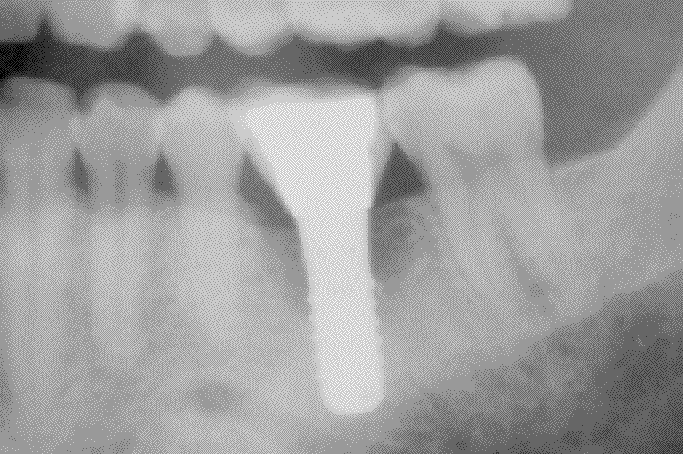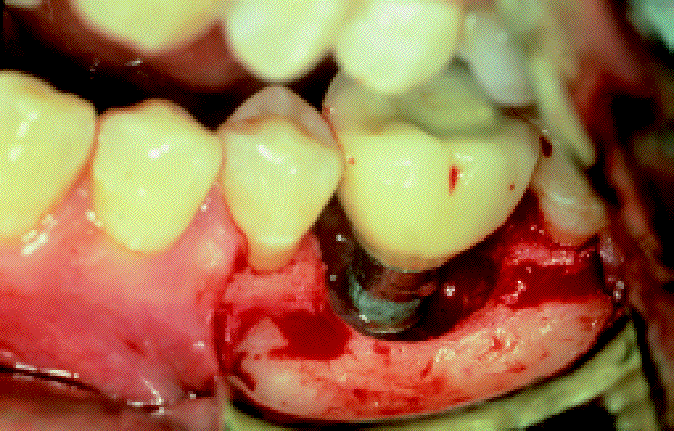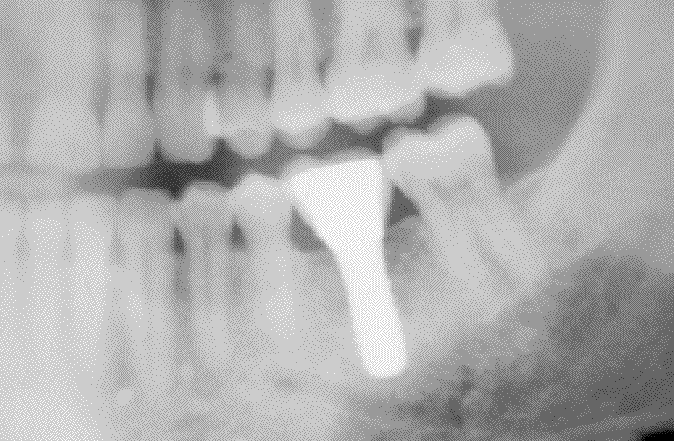Mi SciELO
Servicios Personalizados
Revista
Articulo
Indicadores
-
 Citado por SciELO
Citado por SciELO -
 Accesos
Accesos
Links relacionados
-
 Citado por Google
Citado por Google -
 Similares en
SciELO
Similares en
SciELO -
 Similares en Google
Similares en Google
Compartir
Medicina Oral, Patología Oral y Cirugía Bucal (Ed. impresa)
versión impresa ISSN 1698-4447
Med. oral patol. oral cir. bucal (Ed.impr.) vol.9 no.2 mar./abr. 2004
Marginal peri-implantitis due to occlusal overload. A case report
URIBE R, PEÑARROCHA M, SANCHIS JM, GARCÍA O. MARGINAL PERI-IMPLANTITIS DUE TO OCCLUSAL OVERLOAD.
A CASE REPORT. MED ORAL 2004;9:159-62.
SUMMARY
The etiology of marginal peri-implantitis describes an infectious
factor and a biomechanical factor resulting from occlusal overload.
Clinical and experimental articles oriented to the biomechanical
factor are scarce, so as the studies about the histology associated
to periimplantitis.
We present a case of marginal peri-implantitis on an implant in
the mandibular molar zone caused by occlusal overload, which led to
an osseous defect on the marginal crest. The treatment was composed
of occlusal adjustment, removal of contaminated surgical tissue, and
autogenous bone graft, which varies from the common treatment of
infectious peri-implantitis. Histologic analysis of peri-implantitis
tissue reveals a juxtaepithelial lympho-plasmocytorious infiltrate
and a central zone of dense fibro-connective tissue with scanty
inflammatory cells, which differs from the chronic inflammatory
tissue associated with infectious peri-implantitis. Clinical and
radiographic follow-up control after 12 months evidenced the
remission of the symptoms and bone regeneration on the marginal crest.
We consider that in the treatment of marginal peri-implantitis, it
is necessary to continue the studies on the histological differences
between the infectious types and those that are caused by occlusal overload.
Key words: Marginal peri-implantitis, peri-implantitis, implantitis, occlusal overload.
INTRODUCTION
Marginal peri-implantitis is an inflammatory process that affects the surrounding tissues of an osseous-integrated implant and that causes the loss of marginal osseous support (1,2). Bacterial infections (3-5) and occlusal overload (6,7) have been described in its etiology, as well as the possibility of a combination of these factors (8,9).
Experimental studies on animals have mainly been focused on the infectious factor, inducing peri-imlantitis by means of ligatures (10-13). In the mechanically induced peri-implantitis reference is inadequate (6,14). In the same manner, we encountered more microbiological studies made on peri-implantitis (15-18), than histologic studies on the lost implants or implants affected with periimplantitis (19-21). Piatelli and colleagues (19-20) point out the importance of the latter to determine the cause of the implant failure.
We present a case of marginal peri-implantitis on a mandibular molar caused by occlusal overload. Treatment consisted in occlusal adjustment and in promoting bone regeneration by means of autogenous bone graft taken from a torus mandibularis. Our aim is to show the importance of the occlusal overload as an etiological factor of the peri-implantitis, to report the differences that we encountered with respect to what is described of infectious peri-implantitis, and to inform of the successful therapeutic goal on our patient.
CASE REPORT
A 46 year old man, non-smoker and of no relevant pathologic medical background. Fixed prosthetic rehabilitation was done on a single unit implant (ITI SLA. Straumann, Walderburg-Switzerland) located on the area of 36. On the follow-up control, 6 months after cementation, no associated symptomatology was expressed. Clinical examination showed a slight redness of the mucosa adjacent to the implant, as well as a 6mm deep peri-implant pocket that bled slightly with a probe. Articulating paper evidenced positive premature contact on prosthetic crown. Panoramic radiograph revealed a radioluscent area from the marginal bone towards 36 (Fig.1).
Fig. 1. Imagen radiográfica de la pérdida ósea marginal al implante.
Radiographic image of the marginal bone loss on implant.
Occlusal reduction on prosthetic crown was done. Afterwards a mucoperiosteum flap was performed from 35 to 37, observing a soft tissue rollof fibrous aspect that occupied a marginal peri-implantitis bony defect towards 36 (Fig 2). The removal of the pathologic tissue was done with plastic curettes and was sent for anatomopathologic studies. The implant surface was decontaminated with 0,2% chlorhexidine gel for 2 minutes and irrigated with physiologic solution.
Fig. 2. Vista del defecto óseo periimplantario, cubierto por tejido de aspecto fibroso en forma de "collarete".
View of a peri-implantitis osseous defect, covered by a fibrous
looking tissue in the form of a collar.
An extensive flap was done to access a lingual torus mandibularis on the ipsilateral premolar area, which was extracted and broken down into particles to serve as an autograft. The flap was positioned back to its place and sutured with 3.0 silk. Oral hygiene instructions were again given to the patient and was prescribed with 600mg ibuprofen every 8 hours for 4 days and 0.12% chlorhexidine digluconate mouthwash 2 times a day for 2 weeks.
The histopathologic analysis revealed an epithelial connective tissue, with abundant juxtaepithelial lympho-plasmocitarian infiltrate. Below the superficial zone, a dense fibro-connective tissue with few inflammatory cells is appreciated.
12 months after surgical treatment radiograph revealed marginal bone regeneration (Fig.3) and normal clinical aspect, with the absence of symptomatology.
Fig. 3. Detalle de radiografía panorámica donde se observa la recuperación ósea marginal al implante transcurrido un año.
Detail on panoramic radiograph where marginal bone regeneration on implant after one year is observed.
DISCUSSION
Occlusal overload on an implant can originate marginal bone loss (10, 12, 14). Microfractures give rise to an osseous defect without including inflammatory phenomena (22). However, on an experimental study on monkeys, Hurzeler and colleagues (23) did not find significant marginal bone loss on implants with occlusal overload. Also on monkeys, Miyata and colleagues (14) showed that occlusal overload induced by a suprastructure of 100um in height did not provoke bone loss on implants whose marginal gingiva was healthy. Upon inducing inflammation, bone loss was significant. In a premature contact of 180um or more peri-implant bone resorption was produced, even though there was no previous periodontal inflammation. This shows that occlusal overload can break periodontal health equilibrium and that previous gingival inflammation decreases the magnitude of the overload necessary to provoke bone loss. Occlusal overload was the principal factor associated with peri-implantitis in our case.
In the treatment of peri-implantitis we encounter diverse therapeutic objectives aimed at the infectious character of the disease (24, 25), in which the detoxification and treatment of the implant surface; and the use of systemic anti-microbic agents are important. The biomechanical etiology of the peri-implantitis, in our case, made us consider the elimination of premature contacts, the autogenous bone graft and the use of topical antiseptic as the therapy of choice, which differs from other treatments of cases with similar bone destruction as described in the literature (24).
The histologic study of the tissue encountered on the site of the bony peri-implant defect reflected fibro-connective predominance over the inflammation, making it different from the findings reported by Piattelli and colleagues (19,20). Wherein 54 failed implants due to peri-implantitis, in which bony sequestrations over the implant surface were found in 10% of the cases, indicating the presence of a great quantity of bacteria and chronic inflammatory infiltrate (macrophages, lymphocytes and plasmatic cells). However, it is quite likened in the description given by the same authors, on the histologic studies on implants extracted due to clinically observed mobility. In which a fibrous connective tissue is observed in the tooth-implant interphase, with the absence of inflammatory cells. We coincide with these authors with respect to the importance of the histologic findings in determining the causes of implantology failures.
REFERENCES
1. Jovanovic SA. The management of peri-implant breakdown around functioning osseointegrated dental implants. J Periodontol 1993;64:1176-83. [ Links ]
2. Albrektsson T, Isidor F. Concensus report of session IV. In: Lang NP, Karring T, eds. Proceedings of the First European Workshop on Periodontology. London: Quintessence; 1994. p. 365-9. [ Links ]
3. Mombelli A, Van Oosten MAC; Schurch E. The microbiota associated with successful or failing osseointegrated titanium implants. Oral Microbiol Immunol 1987;2:145-51. [ Links ]
4. Mombelli A. Etiology, diagnosis, and treatment considerations in peri-implantitis. Curr Opin Periodontol 1997;4:127-36. [ Links ]
5. Lang NP, Mombelli A, Tonetti MS, Bragger U, Hammerle CH. Clinical trials on therapies for peri-implants infections. Ann Periodontol 1997;2:343-56. [ Links ]
6. Isidor F. Loss of osseointegration caused by occlusal load of oral implants. Clin Oral Implants Res 1993;7:143-52. [ Links ]
7. Quirynen M, Naert I, Van Steenberghe D. Fixture desing and overload influence marginal bone lost an fixture succes in the Brånemark system. Clin Oral Impl Res 1992;3:104-11. [ Links ]
8. Esposito M, Hirsch JM, Lekholm U, Thomsen P. Biological factors contributing to failures of osseointegrated oral implants. (II). Etiopathogenesis. Eur J Oral Sci 1998;106:721-64. [ Links ]
9. Saadoun AP, Le Gall M, Kricheck M. Microbial infections and occlusal overload: causes of failure in osseointegrated implants. Pract Periodont Aesthet Dent 1993;5:11-20. [ Links ]
10. Baron M, Hass R, Dörbudak O, Watzet G. Experimentally induced peri-implantitis: A review of diferent treatment methods described in the literature. Int J Oral Maxillofac Implants 2000;15:533-44. [ Links ]
11. Tillmanns HW, Hermann JS, Cagna DR, Burgess AV, Meffert RM. Evaluation on three diferent dental implants in ligature-induced peri-implantitis in the Beagle dog. Part I Clinical evaluation. Int J Oral Maxillofac Implants 1997;12:611-20. [ Links ]
12. Fritz MB, Braswell LD, Koth D, Jeffcoat M, Reddy M, Cotsoni G. Experimental peri-implantitis in consecutively placed, loaded root-form and plate-form implants in adult Macaca mullata monkeys. J Periodontol 1997;68: 1131-5. [ Links ]
13. Grunder U, Hürzeller MB, Schüpbach P, Strub JR. Treatment of ligature-induced peri-implantitis using guided tisue regeneration: A clinical and histologic study in the Beagle dog. Int Oral Maxillofac Implants 1993;8:282-93. [ Links ]
14. Miyata T, Kobayashi Y, Araki H, Ohto T, Shin K. The influence of controled occlusal overload on peri-implant tissue. Part 3: A histologic study in monkeys. Int J Oral Maxillofac Implants 2000;15:425-31. [ Links ]
15. Nakou M, Mikx FHM, Oostewaal PJM, Kryijsen JCWM. Early microbial colonization of permucosal implants in edentulous patients. J Dent Res 1987; 66:1654-7. [ Links ]
16. Mombelli A, Buser D, Lang NP. Colonization of osseointegrated titanium implants in edentulous patients. Early results. Oral Microbiol Immunol 1998; 3:113-20. [ Links ]
17. Becker W, Becker BE, Newman MG, Nyman S. Clinical and microbiologic findings that may contribute to dental implant failure. Int J Oral Maxillofac Implants 1990;5:31-8. [ Links ]
18. Mombelli A, Marxer M, Garberthüel T, Grundeg U, Lang NP. The microbiota of osseointegrated implants with a history of periodontal disease. J Clin Periodontol 1995;22:124-30. [ Links ]
19. Piatelli A, Scarano A, Dalla-Nora A, De-Bona G, Favero GA. Microscopical features in retrieved human Brånemark implants: a report of 19 cases. Biomaterials 1998;19:643-9. [ Links ]
20. Piattelli A, Scarano A, Piattelli M. Histologic observations on 230 retrieved dental implants: 8 years' experience (1989-1996). J Periodontol 1998 69:178-84. [ Links ]
21. Takeshita F, Kuroki H, Yamasaki A, Suetsugu T. Histopatologic observation of seven removed endosseus dental implants. Int J Oral Maxillofac Implants 1995;10:466-73. [ Links ]
22. Slots J, Bragd L, Wikstrom M, Dahlén G. The occurrence of Actinobacillus actinomycetemcomitants, Bacteroides gingivalis and Bacteroides intermedius in destructive periodontal disease in adults. J Clin Periodontol 1986;13:570-7. [ Links ]
23. Hurzeler MB, Quiñónez CR, Kohal RJ, Rhode M, Strub JR, Teuscher U, et al. Changes in peri-implant tissues subjected to orthodontics forces and ligature breakdown in monkeys. J Periodontol 1998;69:396-404. [ Links ]
24. Sicilia A, Noguerol B, Rodríguez ME. Puesta al día en Periodoncia: Periimplantología. Periodoncia 1994;4:12-26. [ Links ]
25. Mombelli A, Lang N. The diagnosis and treatment of peri-implantitis. Periodontology 2000 1998;17:63-76. [ Links ]











 texto en
texto en 





